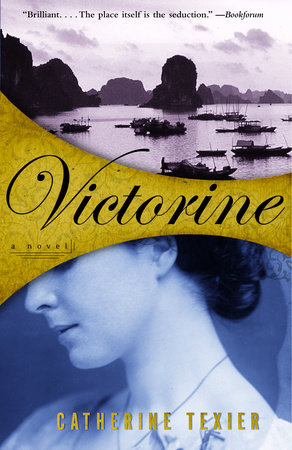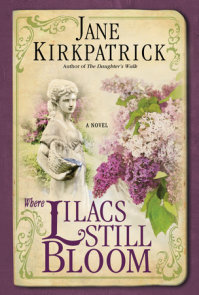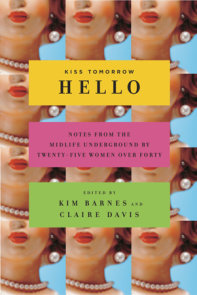READERS GUIDE
“Absorbing. . . . The novelist’s brilliance in evoking the quiet tensions of marriage and motherhood engender an immediate sympathy.” —San Francisco ChronicleThe introduction, discussion questions, suggested reading list, and author biography that follow are intended to enhance your group’s discussion of Catherine Texier’s Victorine. In addition, we’ve included recipes for delicious French treats to serve at your next meeting.
Introduction
In this lush, lyrical, and deeply romantic novel, Catherine Texier takes a mystery from her family’s past and draws from it an unforgettable portrait of a remarkable woman–her great-grandmother, Victorine. A young schoolteacher in a quiet province in France, Victorine marries and has two children. But when she falls desperately in love, she commits a mother’s ultimate sin, leaving her family for her lover and a new life in Indochina. On a single day in 1940, as Victorine reflects on her past, she takes the reader from the willow-lined canals of her childhood home to sun-drenched days and languorous nights along the Mekong River at the dawn of the twentieth century. Hers is an unforgettable story of adventure and self-discovery–of a woman’s struggle between duty and independence, tradition and freedom, longing and regret.Questions and Topics for Discussion
1. How would you describe Texier’s writing style? Why has she chosen to structure the narrative around a single day late in Victorine’s life and interweave it with flashbacks? How does this structure work with the plot and the atmosphere of the novel? What effect does the structure have on the reader that a straightforward, chronological structure would not? What is the purpose of Texier’s prologue and epilogue?
2. Describe the different places in Victorine. What do the landscapes hold for the characters and the story? How do the characters react differently to the various landscapes? How are Victorine’s houses in both Vendée and Vietnam described? Why are they described in such detail?
3. How has growing up in a small village in Vendée, on the Atlantic coast of France, affected Victorine’s personality and desires? How has it influenced her decisions and compromises? Why does she escape this world and then abandon her new life and return to France?
4. Why is the tale of how Victorine got her name important? Does it reveal anything about her and what she is going to be like? How do her childhood and her parents mold the adult that Victorine becomes? Describe her parents. In what ways is she similar to her father? How does he encourage her to follow her dreams?
5. Antoine tells Victorine, “I will not betray you” [p. 158]. But Victorine reflects that she is the betrayer. Discuss the theme of betrayal in this novel. What types of betrayal occur in the novel? Who betrays whom? Is silence a betrayal? Antoine tells Victorine, “It’s your silence that is poisoning your life” [p. 241]. Do you agree with this statement? Are the French betraying the Vietnamese? Are they betraying the democratic ideals of their home country?
6. What is the role of opium in the novel? How do the various characters react to it and change their opinion of it over the course of the novel? How do the French use it to control the Vietnamese? How do various people use it to control others? Why do the French tax opium? What do you learn about French colonialism in Indochina through reading Victorine?
7. Discuss the theme of the corset and the unhooked woman in Victorine.
8. How are the characters of Antoine and Armand both similar and different? How does each court Victorine and win her heart? What attracts her to each man? Is her relationship with each man different? What determines and undermines Victorine’s romantic attachments? How do the events of the novel shift her ties to each man? Armand explains to Victorine, “If you’re never satisfied with what you have, you’ll always be miserable” [p. 121]. Does she have a satisfying relationship with either man?
9. “How can she, just like that, walk from one man’s bed to another’s?” Victorine asks herself [p. 154]. How and why does she?
10. Describe her relationship with the Buddhist monk. What do they share? What does she learn from him and perhaps he from her? How is he different from the other men in her life?
11. Contrast Victorine with the other women in the novel—her sisters, Armand’s sisters, her mother, and Camille. What is her relationship like with these various women? Why does she want to continue working when all the other women around her are housewives?
12. What kind of mother is Victorine? Why doesn’t she take her children with her when she escapes to Vietnam? How has motherhood transformed or hindered Victorine? What is Victorine’s mother like?
13. The novel raises the question of whether responsibility to one’s family and society is more sacred than being true to oneself. Discuss the tension between responsibility and freedom in Victorine’s life. How does she both escape and embrace her feelings of captivity and independence? Does she remain true to herself with her decisions?
14. Victorine is filled with references and allusions to books and to writing. In what ways is the novel both telling a story and commenting on the importance of stories and novels in our lives? What is the importance of novels about women and far-off lands to Victorine? Who are her favorite novelists? Name some of the books mentioned. What is the significance of the references to writing—postcards, journals, letters, teaching the students to spell, and learning Chinese calligraphy?
15. Why does Victorine throw away the notebook of her journal entries after keeping it for so many years?
16. What is the significance of the abundant ocean and water imagery (the canals of Vendée, the Mekong River) in Victorine? What do the beach and the ocean represent for Victorine? What about the stuffed seagull?
About this Author
Catherine Texier is the author of three previous novels, Chloé l’Atlantique, Love Me Tender, and Panic Blood, and a memoir, Breakup. She was the coeditor of the literary magazine Between C & D, is a regular contributor to The New York Times, and has written for Newsday, Elle, Harper’s Bazaar, Cosmopolitan, Marie Claire, and Nerve.com. Texier lives in New York City.Suggested Reading
Nguyen Du, The Tale of Kieu; Marguerite Duras, The Lover; Gustave Flaubert, Madame Bovary; John Fowles, The French Lieutenant’s Woman; Henrik Ibsen, A Doll’s House; Kazuo Ishiguro, When We Were Orphans; Pierre Loti, A Pilgrimage to Angkor; Daniel Mason, The Piano Tuner; Michael Ondaatje, The English Patient; Thomas De Quincey, Confessions of an English Opium-Eater; Stendhal, The Red and the Black; Leo Tolstoy, Anna Karenina; Robert James Waller, The Bridges of Madison County.For further viewing (Movies):
Indochine (France, 1992); The Lover (France, 1991); The Scent of Green Papaya (France/Vietnam, 1993).
PLUS:
Culinary ideas (to serve at your book club gathering):
“The food in Saigon was the most delicious she had ever eaten” [p. 250].
Vietnamese Green Papaya Salad (serves 6):
For dressing:
3 tablespoons soy sauce
1/4 cup sesame oil
1/8 cup rice wine vinegar
1 tablespoon ground white pepper
1/4 teaspoon cayenne pepper
Juice of 1 fresh lime
3 tablespoons sesame seeds, toasted
For salad:
2 small green papayas, julienned
1 small red onion, diced
1 red pepper, diced
4 scallions, chopped
1/4 bunch of cilantro, chopped
In a small bowl, mix together the dressing ingredients. Place salad ingredients in bowl, pour dressing over top and mix. Serve at room temperature.
“Victor-Paul picks up a crêpe from the platter and whistles appreciatively. The crêpes are golden, glittering with butter and sugar” [p. 45].
French Crêpes (makes about 20 crêpes):
2 large eggs
3/4 cup milk
1/2 cup water
1 cup flour
3 tablespoons melted butter
Butter, for coating the pan
In a blender, combine all of the ingredients and pulse for 10 seconds. Place the crêpe batter in the refrigerator for 1 hour. Heat butter in a small nonstick pan. Pour 1 ounce of batter into the center of the pan and spread evenly. Cook for 30 seconds and flip. Cook for another 10 seconds and remove to the cutting board. Lay them out flat so they can cool. Continue until batter is finished.




















